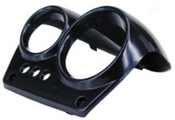ASA
Thermoplastics > Styrenics

| ASA Acrylonitrile-styrene-acrylate-nitrile | ||||||||
Products range (XDUR A) | ||||||||
In Mexpolimeros we offer a wide range of ASA resin and compounds developed according to their needs, ensuring quality products and service. Our product range includes degrees unreinforced, g Rados high gloss, c on glass fiber and / or mineral filler (Ibridos), loaded with metals, modified impact, with special additives as STABILIZER heat, UV, metals , antistatic, antibacterial, laser marking, etc. nucleated, especially flame retardant lubricant (with or without halogen). E offer also developed and evaluated by highly qualified staff and advanced technology. Generating degrees ASA resin with UV protection Mexpolimeros,It is often used for demanding automotive projects, such as radiator grills and mirror housings, three years after its introduction. |  | |||||||
| ASA acrylonitrile-styrene-acrylate-nitrile | ||||||||
What is ASA polymer? The ASA is an advanced amorphous terpolymer of acrylonitrile styrene acrylate are among the products with more resistance to weathering. It can be considered as a compromise between an ABS and a PMMA (but not transparent). The acrylic polymer phase of this confers an intrinsic resistance to UV rays (such as PMMA), combined with good toughness in terms of typical ABS impact strength. It offers exceptional durability in outdoor environments without paint. The advanced compound of mixtures and resin ASA offer an excellent esthetics, variety of colors, good chemical resistance and excellent thermo-resistance and capacity of treatment. It can be incorporated in alloys, combinations and mixtures to benefit from the properties of the component resins, for example, ASA mixed with polyvinyl chloride (PVC) resins for extruded walls, or with polycarbonate (PC) resins for thermo-resistant applications. . Molded to achieve a maximum aesthetic effect with an excellent and long-lasting shine. The thermoplastic ASA was created with the intention of creating a material similar to ABS but with better resistance to weathering. This has allowed the use of this material to increase in the automotive industry as well as in other outdoor applications. |  | |||||||
| Symbols | Formula | |||||||
| ||||||||
| ASA Advantages | ASA Disadvantages | |||||||
|
Properties
|  | ||||||
| ASA Physical and mechanical properties | ||||||||
Acrylate styrene acrylonitrile (ASA), also called acrylonitrile acrylic styrene, is a thermoplastic developed as an alternative to acrylonitrile butadiene styrene (ABS), but with better weather resistance, and is widely used in the automotive industry. ASA has excellent mechanical characteristics, aesthetics and brightness but, most importantly, the weatherability and is suitable, therefore, in all outdoor applications subject to the action of UV rays unlike ABS, hard and scratch resistant, good test sound through high damping mecánica.Al be an amorphous polymer it has a low shrinkage rate. The post-shrinkage is negligible in most applications, which is about 1/10 of the total shrinkage. ASA is compatible with some other plastics, namely polycarbonate and polyvinyl chloride. ASA exhibits low molding shrinkage. | ||||||||
| ASA Thermal properties | ||||||||
It provides a relative temperature index (RTI) of 125 & 176º F (176 ° C & 50), and a heat distortion temperature (HDT) of 220 & 176º F (104 & 176 ° C). The latter has a lower glass transition temperature than the previous, -65 ° C vs. -45 ° C, which provides improved low temperature properties to the material. The acrylate rubber is unlike rubber based on butadiene in the absence of double bonds, which gives the material about ten times the weatherability and resistance to ultraviolet radiation from ABS, higher heat resistance to long term and better chemical resistance. ASA generates toxic fumes when burned. | ||||||||
| ASA Electrical properties | ||||||||
| Being a slightly polar material, with a high TG and low water absorption, the electrical properties are hardly affected by the temperature variation, frequency (up to 106 Hz) and humidity within normal working ranges. | ||||||||
| Optical properties | ||||||||
| ASA saves on painting costs, while offering a good surface quality and shine in the shade | ||||||||
| Chemicals properties | ||||||||
| Excellent weather resistance and gloss retention with exceptional outdoor durability. Not only aesthetic but also maintains the mechanical properties under prolonged exposure to sunlight, moisture and heat. It is attacked by concentrated acids, aromatic and chlorinated hydrocarbons, esters, ethers and ketones | ||||||||
| ASA Processability | ||||||||
ASA pellets can be easily molded by injection, extrusion or molding or using the rotation system. Molded for maximum aesthetic effect with excellent and lasting shine. ASA granules generates toxic fumes when printing so it is very important to inject a well ventilated. The ASA can be processed by extrusion and coextrusion, thermoforming, injection molding, blow molding and extrusion molding of structural foam. The ASA is slightly hygroscopic, drying is necessary before processing. ASA blends with other thermoplastics such as polystyrenes, polyolefins and polyamides.ASA can be welded to itself or some other plastic. Ultrasonic welding can be used for bonding PVC ASA, ABS, SAN, PMMA and some others. ASA can be glued with cyanoacrylate, adhesives and epoxies to attach chloroprene ASA with wood and metal. | ||||||||
| ASA polymerization | ||||||||
What is ASA plastic material? ASA es un terpolímero que puede producirse mediante un proceso patentado de reacción patentado o mediante un proceso de injerto. En el método de reacción, el ASA polimero se realiza mediante la introducción de un elastómero de éster acrílico injertado durante una copolimerización de estireno y acrilonitrilo (SAN). El polvo finamente dividido se distribuye uniformemente y se injerta en las cadenas moleculares de SAN. La excelente resistencia a la intemperie de ASA se debe al éster elastómero acrílico.Acrylic elastomers used may be poly (n-butyl acrylate), poly (ethyl acrylate) and / or poly (2-ethyl hexyl acrylate). A typical formulation of acrylonitrile-styrene-acrylate is 5 to 35% by weight of a crosslinked styrene-acrylonitrile and 15 to 85% by weight of a styrene-acrylonitrile linear or uncrosslinked. The composition is made by a three step sequence comprising:
| ||||||||
| Differences between ABS and ASA | ||||||||
Mexpolimeros offers a variety of thermoplastic materials, all of which are designed to form strong, durable parts. Traditionally, consumers tend to gravitate toward the ABS because it is the best known of the thermoplastic materials Mexpolimeros offers. Similar to the ABS materials, ASA is also a thermoplastic production grade known for its strong material properties. It is also used for the range of applications to create concept models, functional prototypes, manufacturing tools and production parts. ASA equals or exceeds the mechanical properties of standard ABS and has higher heat resistance. Moreover, ASA polymer shows exceptional UV stability, with aCabado mate offers the best aesthetics of any thermoplastic. Its especially suitable for parts of end use in commercial applications and outdoor infrastructure and its wide range of color options exceeds that of ABS. |  | |||||||
| ASA Applications | ||||||||
Product development and applications tend to focus on resistance to UV rays, which is a key product of this class of property. The excellent resistance to UV radiation and chemicals make it a superior and durable alternative, especially for outdoor applications without coating.With this valuable plastic material parts, gloss and scratch resistant are made. Adding opacifiers surfaces can be obtained automotive opaque sector. It is used for mirrors and radiator grilles, spoiler, bicycle parts and motorcycle range. Electrical and electronic, electrical panels, connectors, terminal blocks, housings buttons for cooking and vacuum equipment, control panels and building appliances, sanitary fittings, furniture, equipment lawn and garden, sporting goods, outdoor auto parts , safety helmets and supplies,beam, external ventilation grills badges, headlights. It is a thermoplastic that combines mechanical strength, resistance to UV rays, water resistance and a high finish without presenting deformation. The ASA can be used as an additive for other polymers, when their heat distortion (which results in deformed parts made of the material) should be reduced. ASA with silver compounds, makes its surface antimicrobial oligodynamic effect of the silver. E l high flow construction used in response to environmental protection and new energy material. Future product development will gradually replace the special ABS to meet environmental protection technology and electroplating spray.Compared with other materials, the ASA has significant properties as heat resistance and aging, high surface finish, high tensile strength and resistance to chemicals; these properties are increasing application of ASA, especially in the automotive sector. In a vehicle, ASA is used in the manufacture of the instrument panel, interior parts, lighting covers, and other electrical parts. The construction industry offers great potential ASA in extrusion, for example, for floors terraces, wall coverings and window profiles, but may also impose extreme demands of durability and color fastness. | ||||||||
